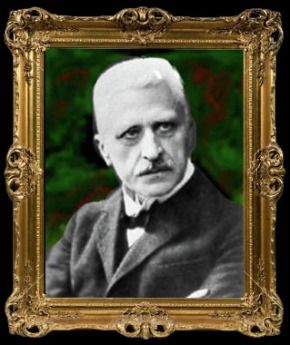
Rudolf Otto
The concept of the numinous derives from the writings of Rudolf Otto (1869-1937), a German theologian and scholar who, in his book "The Idea of the Holy" (1958) sought to explore the non-rational component of religion. By the "non-rational" component of religion Otto was referring to aspects of religion other than dogma and systems of ethics, instead Otto was concerned with religious feelings. He considered the source of such religious feelings to be an encounter with the numinous, which he describes as:
"...a unique 'numinous' category of value and of a definitely 'numinous' state of mind... This mental state is perfectly sui generis and irreducible to any other' and therefore, like every absolutely primary and elementary datum, while it admits of being discussed, it cannot be strictly defined"
This feeling, then, cannot be defined it can only be understood through direct personal experience. Otto does, however, suggest a way by which an individual can be led towards understanding what he means when he refers to the numinous:
"...a unique 'numinous' category of value and of a definitely 'numinous' state of mind... This mental state is perfectly sui generis and irreducible to any other' and therefore, like every absolutely primary and elementary datum, while it admits of being discussed, it cannot be strictly defined"
This feeling, then, cannot be defined it can only be understood through direct personal experience. Otto does, however, suggest a way by which an individual can be led towards understanding what he means when he refers to the numinous:
"There is only one way to help another to an understanding of it. He must be guided and led on by consideration and discussion of the matter through the ways of his own mind, until he reach the point at which 'the numinous' in him perforce begins to stir, to start into life and into consciousness"
We can be guided towards attaining this sensation through considering the idea: through thinking about it. In an effort to give the reader more food for thought, therefore, in the hope that he/she might come closer to personally experiencing the numinous, Otto alerts us of the existence of two distinct aspects of the the numinous; the mysterium tremendum (the element associated with overwhelming fear and awe of the unknown) and the mysterium fascinans (the element associated with feelings of love, mercy, joy and so on). In the context of supernatural horror fiction it is the element of mysterium tremendum that primarily concerns us here:
Mysterium Tremendum:
"'Religious dread' (or 'awe') would perhaps be a better designation. Its antecedent stage is 'demoniacal dread' (cf. the horror of Pan) with its queer perversion, a sort of abortive offshoot, the 'dread of ghosts'. It first begins to stir in the feeling of 'something uncanny', 'eerie', or 'weird'. It is this feeling which, emerging in the mind of primeval man, forms the starting-point for the entire religious development in history. 'Daemons' and 'gods' alike spring from this root, and all the products of 'mythological apperception' or 'fantasy' are noting but different modes in which it has been objectified"
In this we see a striking resemblance to the type of fear that H.P. Lovecraft wanted to express in his weird stories. Lovecraft termed this fear "cosmic horror":
"The true weird tale has something more than secret murder, bloody bones, or a sheeted form clanking chains according to rule. A certain atmosphere of breathless and unexplainable dread of outer, unknown forces must be present; and there must be a hint, expressed with a seriousness and portentousness becoming its subject, of that most terrible conception of the human brain - a malign and particular suspension of defeat of those fixed laws of Nature which are our only safeguard against the assaults of chaos and the daemons of unplumbed space"
In a sense, therefore, we could suggest that Lovecraft's "cosmic horror" represents a literary and artistic means to express, or translate to the reader, the feeling of the mysterium tremendum.
"'Religious dread' (or 'awe') would perhaps be a better designation. Its antecedent stage is 'demoniacal dread' (cf. the horror of Pan) with its queer perversion, a sort of abortive offshoot, the 'dread of ghosts'. It first begins to stir in the feeling of 'something uncanny', 'eerie', or 'weird'. It is this feeling which, emerging in the mind of primeval man, forms the starting-point for the entire religious development in history. 'Daemons' and 'gods' alike spring from this root, and all the products of 'mythological apperception' or 'fantasy' are noting but different modes in which it has been objectified"
In this we see a striking resemblance to the type of fear that H.P. Lovecraft wanted to express in his weird stories. Lovecraft termed this fear "cosmic horror":
"The true weird tale has something more than secret murder, bloody bones, or a sheeted form clanking chains according to rule. A certain atmosphere of breathless and unexplainable dread of outer, unknown forces must be present; and there must be a hint, expressed with a seriousness and portentousness becoming its subject, of that most terrible conception of the human brain - a malign and particular suspension of defeat of those fixed laws of Nature which are our only safeguard against the assaults of chaos and the daemons of unplumbed space"
In a sense, therefore, we could suggest that Lovecraft's "cosmic horror" represents a literary and artistic means to express, or translate to the reader, the feeling of the mysterium tremendum.
